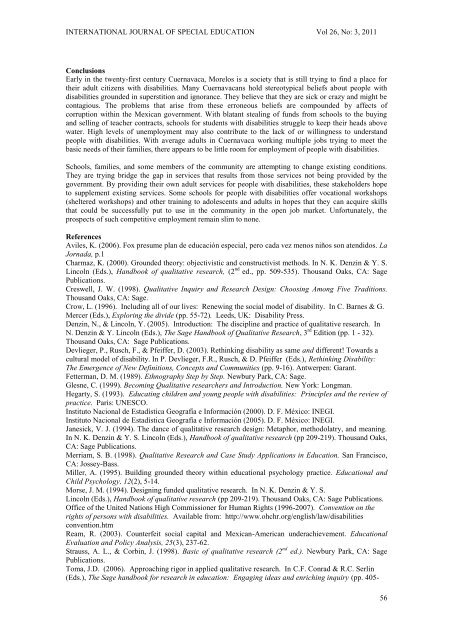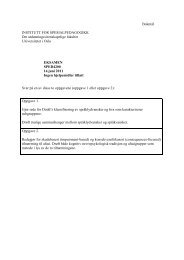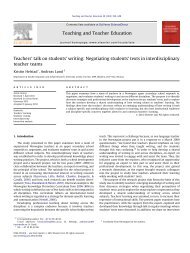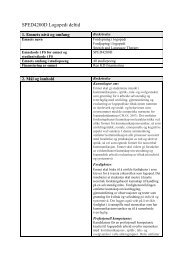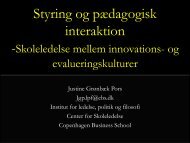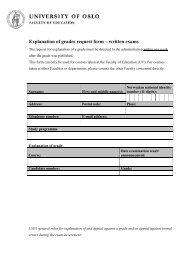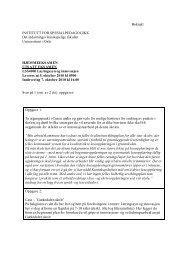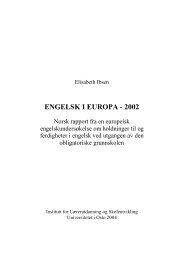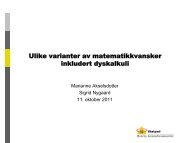International Journal Special Education
International Journal Special Education
International Journal Special Education
Create successful ePaper yourself
Turn your PDF publications into a flip-book with our unique Google optimized e-Paper software.
INTERNATIONAL JOURNAL OF SPECIAL EDUCATION Vol 26, No: 3, 2011ConclusionsEarly in the twenty-first century Cuernavaca, Morelos is a society that is still trying to find a place fortheir adult citizens with disabilities. Many Cuernavacans hold stereotypical beliefs about people withdisabilities grounded in superstition and ignorance. They believe that they are sick or crazy and might becontagious. The problems that arise from these erroneous beliefs are compounded by affects ofcorruption within the Mexican government. With blatant stealing of funds from schools to the buyingand selling of teacher contracts, schools for students with disabilities struggle to keep their heads abovewater. High levels of unemployment may also contribute to the lack of or willingness to understandpeople with disabilities. With average adults in Cuernavaca working multiple jobs trying to meet thebasic needs of their families, there appears to be little room for employment of people with disabilities.Schools, families, and some members of the community are attempting to change existing conditions.They are trying bridge the gap in services that results from those services not being provided by thegovernment. By providing their own adult services for people with disabilities, these stakeholders hopeto supplement existing services. Some schools for people with disabilities offer vocational workshops(sheltered workshops) and other training to adolescents and adults in hopes that they can acquire skillsthat could be successfully put to use in the community in the open job market. Unfortunately, theprospects of such competitive employment remain slim to none.ReferencesAviles, K. (2006). Fox presume plan de educación especial, pero cada vez menos niños son atendidos. LaJornada, p.1Charmaz, K. (2000). Grounded theory: objectivistic and constructivist methods. In N. K. Denzin & Y. S.Lincoln (Eds.), Handbook of qualitative research, (2 nd ed., pp. 509-535). Thousand Oaks, CA: SagePublications.Creswell, J. W. (1998). Qualitative Inquiry and Research Design: Choosing Among Five Traditions.Thousand Oaks, CA: Sage.Crow, L. (1996). Including all of our lives: Renewing the social model of disability. In C. Barnes & G.Mercer (Eds.), Exploring the divide (pp. 55-72). Leeds, UK: Disability Press.Denzin, N., & Lincoln, Y. (2005). Introduction: The discipline and practice of qualitative research. InN. Denzin & Y. Lincoln (Eds.), The Sage Handbook of Qualitative Research, 3 rd Edition (pp. 1 - 32).Thousand Oaks, CA: Sage Publications.Devlieger, P., Rusch, F., & Pfeiffer, D. (2003). Rethinking disability as same and different! Towards acultural model of disability. In P. Devlieger, F.R., Rusch, & D. Pfeiffer (Eds.), Rethinking Disability:The Emergence of New Definitions, Concepts and Communities (pp. 9-16). Antwerpen: Garant.Fetterman, D. M. (1989). Ethnography Step by Step. Newbury Park, CA: Sage.Glesne, C. (1999). Becoming Qualitative researchers and Introduction. New York: Longman.Hegarty, S. (1993). Educating children and young people with disabilities: Principles and the review ofpractice. Paris: UNESCO.Instituto Nacional de Estadística Geografía e Información (2000). D. F. México: INEGI.Instituto Nacional de Estadística Geografía e Información (2005). D. F. México: INEGI.Janesick, V. J. (1994). The dance of qualitative research design: Metaphor, methodolatry, and meaning.In N. K. Denzin & Y. S. Lincoln (Eds.), Handbook of qualitative research (pp 209-219). Thousand Oaks,CA: Sage Publications.Merriam, S. B. (1998). Qualitative Research and Case Study Applications in <strong>Education</strong>. San Francisco,CA: Jossey-Bass.Miller, A. (1995). Building grounded theory within educational psychology practice. <strong>Education</strong>al andChild Psychology, 12(2), 5-14.Morse, J. M. (1994). Designing funded qualitative research. In N. K. Denzin & Y. S.Lincoln (Eds.), Handbook of qualitative research (pp 209-219). Thousand Oaks, CA: Sage Publications.Office of the United Nations High Commissioner for Human Rights (1996-2007). Convention on therights of persons with disabilities. Available from: http://www.ohchr.org/english/law/disabilitiesconvention.htmReam, R. (2003). Counterfeit social capital and Mexican-American underachievement. <strong>Education</strong>alEvaluation and Policy Analysis, 25(3), 237-62.Strauss, A. L., & Corbin, J. (1998). Basic of qualitative research (2 nd ed.). Newbury Park, CA: SagePublications.Toma, J.D. (2006). Approaching rigor in applied qualitative research. In C.F. Conrad & R.C. Serlin(Eds.), The Sage handbook for research in education: Engaging ideas and enriching inquiry (pp. 405-56


